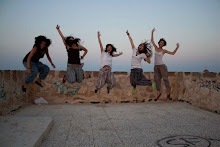


While el mercadillo slips its way through narrow residential roads, el mercado stretches across two wide streets. Both markets are teeming with people, clothes, shoes, bags, produce, cheeses, and churros. Crowds, products, boxes, and tables invade onto the streetscape. Even though the streets of el mercado are wider, a different level of obstructions surfaced with the abundance of portable shopping carts. These plastic, brightly colored contraptions wheel after their owners, who are too distracted by pouches and potatoes to notice when their carts collide into others (or others’ camera lenses). These carts caused the wider streets to feel even more contracted than the paths back in el mercadillo. As such, the sidewalk served even more as a space of retreat for the shopkeepers who could escape from the chaos of the street.

The quantity of portable shopping carts was dizzying (and painful).

The sidewalk as a space of retreat for the shopkeepers.
Aside from el mercado, the students also studied the city hall building by Rafael Moneo and its contextual response. The very modern building faces a classical plaza with a Gothic style church. Its façade is made up of limestone panels. Alex shared with us his understanding of limestone as a material built up over time of calcium and animal remains. Curious how such a temporal material adorns a new building – perhaps an attempt to pay respect to the history of the square? This material choice is similar to building in areas dominated by old brick structures with corten steel, a metal that oxidizes quickly to take on a deep reddish-orange color. The façade is reminiscent of Giuseppe Terragni’s Casa del Fascio in Como, Italy. Both have an opening for a political leader to walk out and address people from above. The two buildings use a relationship to existing classical town landmarks to assert the status of modern aesthetic and thinking. Both also make use of a compositional exterior, but the Casa del Fascio boasts a dynamic interior where spaces blur and redefine through a symphony of lines and planes. Its exterior also shifts with doors that swing open in harmony to release marching soldiers and a blank wall for hanging propaganda. Though the exterior of the Murcia city hall is striking because of contextual contrast, the students who managed to visit the interior reported that it was an unremarkable series of offices with no natural daylight.

The city hall building serves as a terminal accent among the neighboring classic Spanish style buildings.

A close-up of the city hall's facade, with the Gothic church directly opposing it reflected in the glass for the mayor's balcony.


Excerpts from sketchbook on Murcia.
Lastly, a little research the night before our visit led me to a website that recommended sampling several Murcia dessert specialties. It suggested a dish called paparajotes (lemon leaves fried in crispy batter, then dusted in sugar and cinnamon), leche frita (fried milk), and fig sorbet. Jen, Cara, Kayla, and I embarked on a mission to find paparajotes. After visiting almost ten restaurants, bakeries, and pastry shops, we discovered that paparajotes was a seasonal festival food served only at very high class restaurants. So much for following research. I ended up getting miloja (?), a slice of cream and thin puff pastry at a small bakery... Delicious and nicely wrapped.

The closest I got to paparajotes.
The construction of the packaging is brilliant.


No comments:
Post a Comment